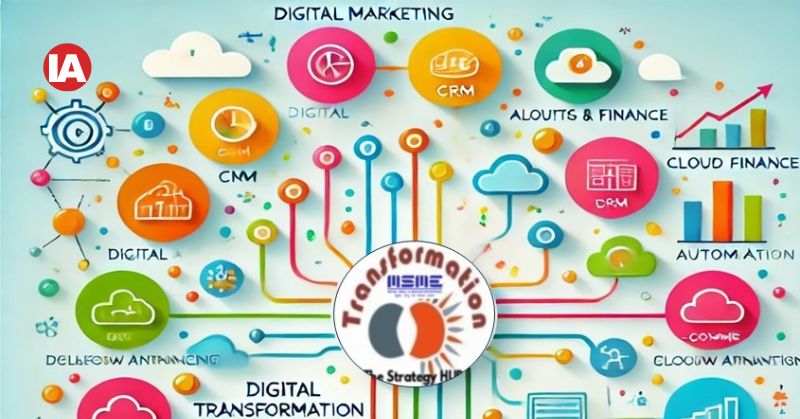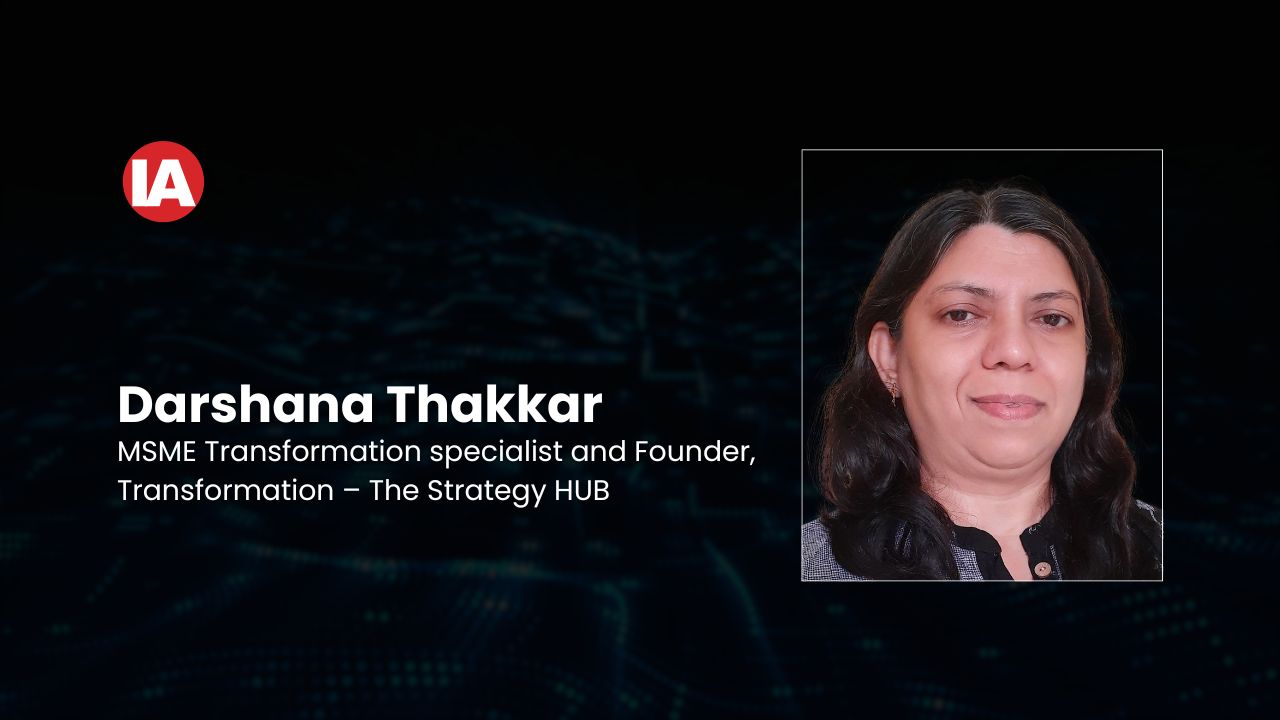
SMEs and the Need for Digital Transformation
Digital transformation is crucial for small and medium enterprises (SMEs) to remain competitive in today’s global marketplace. Darshana Thakkar offers valuable insights on how MSMEs can begin their digital journey with minimal investment, emphasizing the power of small, incremental steps. From enhanced customer engagement to operational efficiency, this article presents actionable tips for MSMEs to kickstart their digital transformation and position themselves for growth.
![[object Object]](https://admin.industrialautomationindia.in/storage/articles/article-vw9JLylJMDnIYqfOe3A68GQWVhActPah1ni3SL6C.jpg)
The journey of digital transformation begins with small, incremental steps tailored to the specific needs and budget of the business, says Darshana Thakkar.
In today’s rapidly evolving business landscape, digital transformation has emerged as a game-changer for organisations of all sizes. While large corporations often have the resources to adopt cutting-edge technologies, small and medium enterprises (SMEs) face unique challenges due to limited budgets and resources. Now it is high time for MSMEs to gain the most from leveraging digital solutions to enhance efficiency, improve customer engagement, and stay competitive in a globalised market.
At the beginning of 2025, I would like to share insights about how MSMEs can explore digital transformation, emphasizing their role in driving growth and sustainability. I am sharing some key areas where SMEs can begin their digital journey with minimal investment, demonstrating that transformation does not always require hefty budgets or complex infrastructure.
Through this article, I will provide actionable insights to help navigate the path to digital success. Let us embark on this transformative journey together and uncover how even the smallest steps can lead to monumental progress.
Why digital transformation in SMEs in the current era
Digital transformation is no longer a luxury but a necessity for small and medium enterprises (SMEs) in the current era for sustainable growth
1. Competitive Edge in a Digital World
• Due to globalisation, SMEs are no longer competing just locally but globally. Digital tools enable them to access wider markets.
• Today's customers expect fast, personalised, and seamless experiences, which are possible only through digital technologies.
2. Operational Efficiency
• Streamlining repetitive tasks through automation saves time and reduces errors.
• Leveraging Data-Driven Decisions provides insights for better decision-making.
• Digital tools can reduce operational costs, increasing profitability.
3. Enhanced Customer Engagement
• Online presence and Digital Marketing platforms enable SMEs to reach and engage with their target audience effectively.
• Customer Relationship Management (CRM) Tools help manage customer data and improve relationships, leading to better customer retention.
4. Resilience Against Disruptions
• Learnings during Covid-19 Pandemic highlighted the importance of being digitally ready to adapt to sudden disruptions.
• Digital transformation enhances Remote Work Capabilities and supports flexible work arrangements, ensuring business continuity.
5. Access to Government Support
• Many governments offer incentives and schemes for SMEs adopting digital technologies. Being digitally transformed helps SMEs leverage these benefits.
6. Sustainability and Scalability
• Paperless Operations help to reduce environmental impact and operational costs.
• Cloud-based tools grow with the business, eliminating the need for constant upgrades.
7. Staying Relevant in Industry 4.0
• SMEs must adopt Integration with IoT, AI, and Big Data to stay competitive in an industry driven by automation and connectivity.
• Smart Manufacturing optimises production, improves supply chain management, and reduces waste.
How to start Digital Transformation
1. Assess Readiness: Identify current gaps and opportunities.
2. Strategic Planning: Define clear objectives and align them with business goals.
3. Adopt Technologies: Choose solutions like CRM, ERP, cloud computing, and analytics.
4. Employee Training: Upskill the workforce to adapt to new technologies.
5. Iterative Improvement: Regularly review and refine strategies.
Now the question arises of where to start and how to start Digital transformation with a limited budget and in a phased manner. Every organisation has specific requirements and needs based on the business model, customer base,and organisational culture. I am sharing actionable Insights for SME about why and how to start Digital Transformation with its key benefits.
Key areas where SMEs can start digital transformation on a limited budget

1. Digital Marketing
Why: Increases visibility and helps reach a wider audience cost-effectively.
How to Start:
• Social Media Marketing through business profiles on free platforms like Facebook, Instagram, and LinkedIn.
• Content Marketing by Publishing blogs or videos.
• Email Campaigns by using free tools like Mailchimp or SendinBlue.
Benefits:
• Enhances brand visibility.
• Engages customers directly.
• Generates measurable results.
2. Customer Relationship Management (CRM)
Why: Streamlines customer data management and improves relationships.
How to Start:
• Implement free or affordable CRM software like HubSpot CRM, Zoho CRM
• Use CRM to track customer interactions, sales opportunities, and feedback.
• Automate follow-ups and reminders to improve customer retention.
Benefits:
• Centralises customer data.
• Improves customer engagement.
• Increases sales efficiency.
3. Accounting and Finance Management
Why: Simplifies financial tracking and ensures compliance.
How to Start:
• Use accounting software like QuickBooks, Tally, or Wave.
• Digitise tax filing and compliance processes to reduce manual errors.
• Automate invoice generation, expense tracking, and tax filing
Benefits:
• Simplifies bookkeeping.
• Improves financial visibility.
• Ensures compliance.
4. Inventory and Supply Chain Management
Why: Optimises stock levels and reduces operational costs.
How to Start:
• Use inventory management software like Zoho Inventory or any locally available.
• Integrate barcoding and RFID systems for real-time tracking.
Benefits:
• Reduces overstock and stockouts.
• Streamlines order fulfillment.
• Reduce hidden costs in non-moving inventory.
5. Workflow Automation
Why: Saves time and reduces human error that makes work system-driven.
How to Start:
• Use tools like Zapier or Integromat to automate repetitive tasks such as email responses or data entry.
• Deploy chatbots like Tidio or Chatfuel for customer support and lead generation.
Benefits:
• Reduces manual effort.
• Saves time and resources.
• Improves accuracy.
6 . Cloud Storage and Collaboration
Why: Enables secure, remote access to data and supports collaboration.
How to Start:
• Use free or low-cost cloud service platforms like Google Drive, Dropbox, or Microsoft OneDrive.
• Use collaborative tools like Google Workspace or Microsoft 365 for shared access to files and communication.
Benefits:
• Provides secure data storage.
• Enables remote work and collaboration.
• Reduces infrastructure costs.
7. Data Analytics
Why: Helps make informed, data-driven decisions.
How to Start:
• Use Google Analytics to track website traffic and user behavior
• Use Excel or free versions of tools like Tableau Public for basic data visualisation and reporting.
Benefits:
• Facilitates data-driven decisions.
• Identifies trends and insights.
• Optimises performance.
8. Employee Training and Development
Why: Builds a digitally skilled workforce.
How to Start:
• Use online learning platforms like Udemy, Coursera, or LinkedIn Learning for affordable training courses.
• Conduct virtual workshops to train employees on specific digital tools.
• Engage with local expert consultants for training in regional language
Benefits:
• Builds a digitally skilled workforce.
• Enhances productivity.
• Reduces resistance to change.
9 . Cybersecurity Measures
Why: Protects business data from threats.
How to Start:
• Implement basic security measures like firewalls, antivirus software, and secure passwords.
• Train employees on safe online practices and phishing awareness.
Benefits:
• Protects business data and reputation.
• Safeguards customer information.
• Reduces risks of cyber threats.
Tips for Budget-Friendly Transformation
1. Start Small: Focus on one area at a time and expand gradually.
2. Leverage Free Tools: Many digital tools offer free versions suitable for small-scale operations.
3. Leverage Free Trials: Many tools offer free trial periods to test their effectiveness.
4. Collaborate with Local Experts: Partnering with local tech consultants can ensure affordable and customised solutions.
5. Use Government Schemes: Take advantage of government grants and programs for digital adoption.
After going through the above information, I believe any small business owner can start a Digital Transformation Journey at least with a small start.
To start with, I am sharing herewith some free or low-cost digital tools that can be explored by SMEs for budget-friendly transformation.
Digital tools for SMEs
• Canva for creating marketing graphics.
• Google My Business for local SEO optimisation.
• Buffer or Hootsuite for managing multiple social media accounts.
• Calendly for scheduling meetings.
• Power BI for advanced data analysis.
• Hotjar for website heatmap analysis.
• Skillshare for upskilling.
• Google Primer for short, actionable business lessons.
• Avast or Norton for antivirus protection.
• LastPass for password management.
Summary
The journey of digital transformation begins with small, incremental steps tailored to the specific needs and budget of the business. With the right mindset, tools, and support, SMEs can unlock new opportunities, navigate challenges, and position themselves as vital contributors to the evolving global economy.
The future belongs to those who adapt and innovate—let’s empower our SMEs to embrace this change and lead the way!

Darshana Thakkar is an MSME Transformation specialist and Founder of Transformation – The Strategy HUB. With an Electrical engineering and MBA in business operations background, she has 28 years of hardcore industrial experience in transforming Small businesses. She helps MSMEs define growth paths, derive marketing strategies, improve business operations, adopt digital Transformation, and increase profitability.Darshana Thakkar is an author, speaker, and TV panelist. Her achievements, journey, and interviews have been featured in several newspapers, Premium business magazines, and TV.
She has won several regional, national, and international awards and is famous as an MSME activist and women's business leader. Her consulting venture, Transformation, was listed among the most trusted consulting companies in 2022 and among the top 50 consulting companies for MSME in 2023. She holds a few honorary positions in industry associations.
Major achievements:
· Winner of Global Women Leader -2023 by Global Women Leadership Award
· MSME Honor award-2022 -Champion of Cause by Tally Solutions
· Winner of Gujarat Women's Leader Award – 2021
She is associated with a few other premier institutes as
· Certified Women Director & Independent Director by IICA, MCA, GoI.
· Member of the Board of Management at Makarpura GIDC Industrial Estate Cooperative Bank Ltd.
· National President: WICCI-Entrepreneurship Development Council
· Trainer, Startup mentor, & Jury member at CED, Government of Gujarat.
https://www.linkedin.com/in/darshanamthakkar/
_____________________________________________________________________________________________
For a deeper dive into the dynamic world of Industrial Automation and Robotic Process Automation (RPA), explore our comprehensive collection of articles and news covering cutting-edge technologies, robotics, PLC programming, SCADA systems, and the latest advancements in the Industrial Automation realm. Uncover valuable insights and stay abreast of industry trends by delving into the rest of our articles on Industrial Automation and RPA at www.industrialautomationindia.in